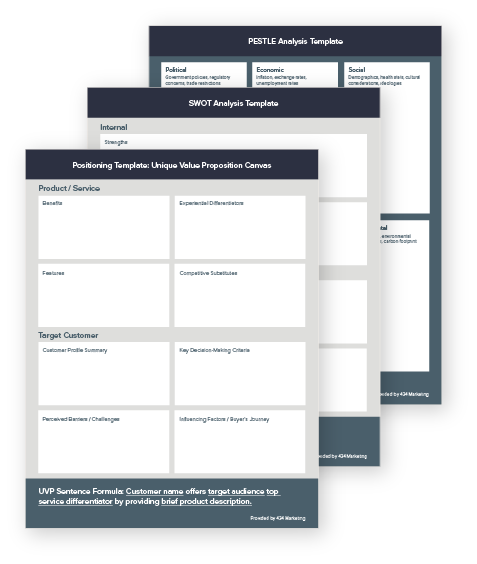Whether you’re a CMO directing a global marketing program, or a social media manager rolling out a new digital campaign – market research is crucial to developing an effective strategy. Conducting market research provides a data-informed picture of the market landscape, the competition, and perceptions of your brand. It also helps marketers identify and leverage untapped promotional opportunities.
Without taking time to gather and analyze a wide spectrum of data, marketers miss important opportunities to attract and cultivate leads, push weak messaging, and waste limited resources.
From quantitative market evaluations and digital analytics to qualitative buyer persona research, market research takes many forms.
In this post, we’ll explore key facets of market research and strategy development, and why they’re important:
- Set Research Goals
- Study Your Target Audience(s)
- Understand Your Competition
- Assess Your Market Position
- Elevate Domain Authority and Build Credibility With Digital Research
Step 1: Set Goals
It’s helpful to start a market research project by setting objectives. These goals can be broad, related to a larger marketing program, or narrow in scope.
Are you launching a new product? Targeting a new market vertical? Or do you want to uncover fresh approaches to growing sales and revenue? Multiple market research tactics can be combined to achieve each individual goal, but understanding the long-term vision will give your project a sturdy foundation, achievable scope, and focused purpose.
Here are some ways to approach market research goal-setting:
Remember to Seek C-Suite Guidance: If you’re in a marketing manager or director role, it’s important to take time at this stage to ask your leadership to describe their top business priorities. Gaining these insights early on helps ensure that research aligns with corporate strategy, and it also gives leadership insight into the type of data and resources you’ll need to tap into.
Set SMART Objectives: An important element of setting market research goals, is to cast a framework for evaluating your work down the road. Making (Specific, Measurable, Achievable, Relevant, and Time-Based) SMART objectives helps marketers maintain accountability. Remember to specify which key performance indicators (KPIs) you want to measure success with early on.
Gather Baseline Data: Research insights don’t always need to demonstrate growth or impact right away. Many large companies regularly repeat the same market research processes to gauge marketing performance over time. For example, if a company wants to understand how prospective buyers perceive a new product that was recently rolled out, they’d need baseline data to compare with future focus group insights. Make sure to archive old focus research reports, and consistently measure similar characteristics with each take so you have relatable trend lines to analyze down the road.
It’s essential to take time to set goals and map out a game plan based on your company’s business objectives. This ultimately helps marketers save resources by addressing the right research questions, narrowing the scope, and ensuring that the research report will actually drive value later on.
Step 2: Study Your Target Audience(s)
You’ve set your project goals. Now it’s time to apply them by making the first strategic decision – which audience segments do you want to target to meet your objectives? Are there multiple audiences in different market verticals that you want to evaluate?
Some companies start this process with a clear picture of their targeted buyers and customer profiles, while others take a blank-slate approach and segment audiences after gathering data. Both approaches can be effective. Canvassing a range of buyers with different characteristics, job titles, product selections, and buying impulses can yield extremely valuable insights into your brand’s market impression.
There are many research methods used to study your audience. Here are just a few tactics we apply at 434 to understand client audiences:
Focus Groups: During a focus group session, the researcher gleans valuable insights via a collaborative discussion among like-minded research participants that represent target audiences.
Surveys: Properly conducted surveys are an efficient way to collect larger amounts of qualitative and quantitative data related to your core research questions from a group of customers, targeted prospects, or even the general public.
Observational Studies: Introduce your research participant to something they haven’t seen before – say, a new software feature or a website your brand is launching – and simply observe them as they use the product. Do they hit roadblocks and show frustration? Do they dislike a specific feature, or get lost in the system? Conducting beta tests, product demos, and user experience (UX) research gives you valuable insights into how real people will perceive and navigate your product.
Demographic Analysis: Collect macro-level data about your ideal buyer’s age, job title, interests, gender identity, ethnicity, education, income, and relevant belief systems.
Digital User Behavior Overviews: Analyze digital analytics to understand when your leads and customers are visiting your website, which pages they’re landing on, what they’re clicking on, average time spent on site, and the devices they’re using.
Search Intent Studies: Screen-record research participants as they navigate search engines and websites, asking them questions about each action (click) along the way.
Buyer Persona Research: Buyer personas are theoretical – yet data-informed – representations of your target customer. Many businesses have multiple buyer personas that each share common decision-making processes and professional characteristics.
Buyer persona research, in particular, is a pinnacle tactic marketers use to define how targeted buyers make purchasing decisions. These important insights give sales and marketing teams direct messaging and customer feedback, allowing them to repeat the successful aspects of the sale, and refine areas that need improvement.
Buyer persona research focuses on identifying narratives for five key sales themes: the buyer’s decision criteria, factors that influence success, perceived barriers, priority initiatives, and the buyer’s journey. To learn more about buyer persona research and how we conduct our customer interviews, here’s a post about our process: “How to Interview Customers to Decode Key Buying Insights.”
Step 3: Understand Your Competition
“Know thy self, know thy enemy.” While modern marketing isn’t warfare, this famous phrase from Tzu’s The Art of War still rings true today. Study your competition regularly, and always be aware of new players entering the market. Analyze your competition’s website performance, messaging, unique value propositions, landing page offers, lead generation strategies, email drip campaign cadence and messaging, social media engagement, and digital community components. Understanding your competitors will help you define your own brand’s position in the market and leverage what makes your offering unique and superior.
Step 4: Assess Your Market Positioning
Where does your brand sit in the market in terms of price and perceived value? How does your product or service differ from your competitors? How do people feel about your brand overall? These are all good questions that can be answered via data collection and positioning analysis.
Basic market positioning centers around the “Four P’s of Marketing”: product, price, place, and promotion. At 434, we conduct one-on-one customer research for our clients, which unveils an important fifth element – perceptions. Crystallizing these components can help you evaluate your brand in the context of competitors, messaging, features and benefits, and promotional avenues.
Here are a variety of different frameworks that will help you define your brand’s position in the marketplace.
- Positioning Messaging: If your business doesn’t have a unique value proposition (UVP) yet – ideally tailored for each target audience segment – then it’s time to get started on them. Your brand’s UVP is a brief statement that clearly differentiates your offering from the competition’s. Download Template
- PESTLE Analysis: The PESTLE Analysis examines the political, economic, social, technological, legal, and environmental external factors influencing corporate success. This popular framework is particularly effective when conducting research in preparation for a product launch, corporate merger, or new partnership. Download Template
- SWOT Analysis: SWOT Analyses help marketers define strengths, weaknesses, opportunities, and threats. You can apply the SWOT framework in multiple situations – from evaluating the pros and cons of a business decision to examining an entire brand. Download Template
- Perceptual Mapping: Perceptual maps help marketers visualize customer insights in a simple two-variable matrix, such as perceived value to price. These maps can evaluate a brand or a specific offering.
Step 5: Elevate Domain Authority and Build Credibility With Digital Research
If one of your marketing goals is to convert more leads digitally, then this section is for you. Your website’s domain authority is a value from 1 to 100 that reflects how likely a search engine result page (SERP) will pull up a page on your site. While domain authority is predominantly built on backlinks from credible websites, there are several other SEO and content marketing factors to consider.
There are many ways to draw significant research insights via digital channels. We tend to start off this process by collecting user and behavior flow analytics, website usability testing, keyword research, and content gap analysis research. Next, we dive into developing content that is most likely to rank highly in search engines. We interview subject matter experts and develop well-researched content that drives a high amount of value to our client’s target audiences. This turnkey process helps generate new backlinks, increases organic web traffic, and improves lead conversion rates over time.
Let’s start researching, together.
434 is an award-winning digital marketing agency. To date, we’ve built 260+ custom websites, served 350 clients nationwide, and churn out roughly 1,000 digital leads for our content marketing client base each month. We specialize in developing premier custom websites and data-driven content marketing strategies that drive lead conversions, engage and cultivate prospects, and stimulate revenue growth.
Want to learn more about our signature research, web, and content marketing processes?
 You’ll receive:
You’ll receive:
